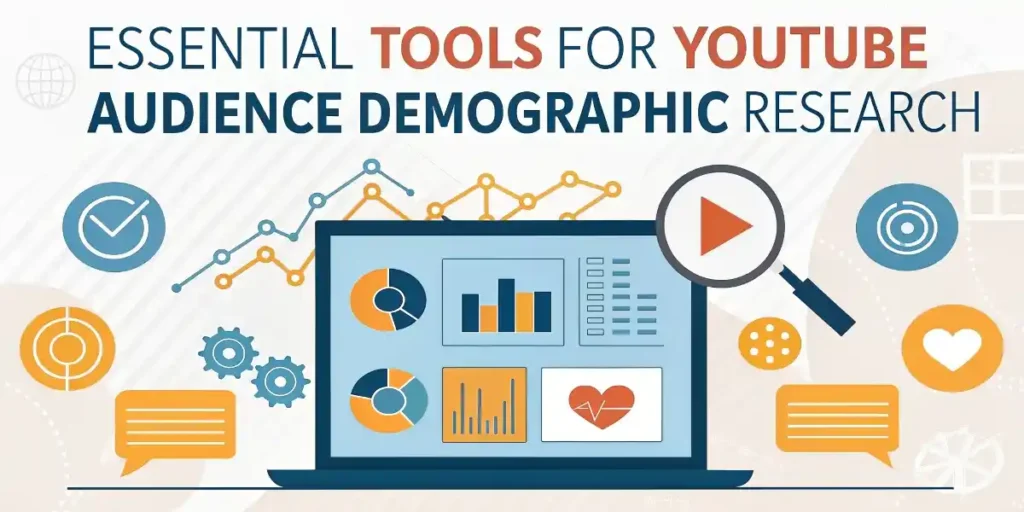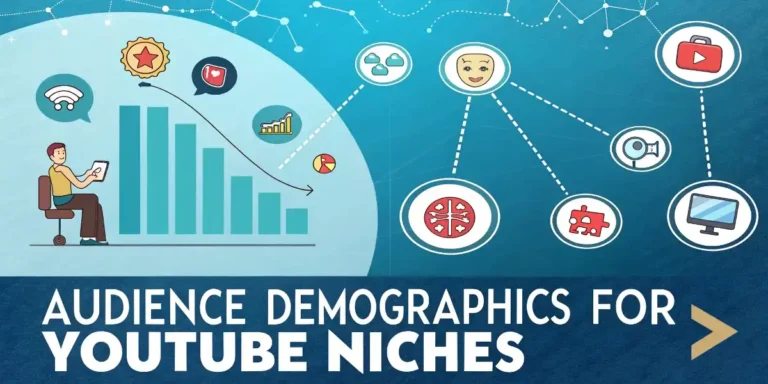Picture this: You spend months creating YouTube content, only to discover your audience is completely different from who you thought you were targeting.
Sound familiar? You are not alone. Most creators guess their way through audience research and wonder why their channels plateau at 10,000 subscribers while others explode to millions.
Understanding YouTube Audience Demographics and Their Impact on Niche Success
Demographics determine everything about your YouTube channel’s success. When you understand who watches your content, you unlock the blueprint for explosive growth.
Think of demographics as your channel’s GPS. Without it, you’re navigating a maze blindfolded, merely hoping to find your way to success by chance.
What Are YouTube Audience Demographics
YouTube audience demographics represent the statistical characteristics of your viewers. This encompasses factors such as age, gender, geographic location, personal interests, and viewing habits..
According to Statista’s 2024 research, 77% of internet users aged 15-35 actively use YouTube, making this the platform’s core demographic.
Your demographic data reveals patterns that predict content performance. For instance, gaming content typically attracts males aged 18-34, while beauty tutorials primarily engage females aged 16-44.
Why Demographics Matter for YouTube Content Strategy
Demographics directly impact your monetization potential. Advertisers pay premium rates for specific audience segments.
Consider this: A financial advice channel targeting viewers aged 25-45 with household incomes above $75,000 commands higher CPM rates than general entertainment content.
Google’s advertiser data shows that targeted demographic campaigns achieve 3x higher conversion rates than broad targeting approaches.
How Demographics Influence Content Performance and Monetization
Your audience demographics determine your content’s viral potential. Different age groups share content differently across platforms.
Gen Z viewers (ages 16-24) prefer short-form content and share through TikTok and Instagram Stories. Millennials (ages 25-40) engage more with long-form educational content and share via Facebook and LinkedIn.
Revenue optimization requires demographic alignment. A channel targeting high-income professionals can successfully promote premium courses, while content for college students performs better with affiliate marketing for budget products.
Essential Tools for YouTube Audience Demographic Research

The right tools transform guesswork into data-driven decisions. Here are the platforms that successful creators use to decode their audiences.
YouTube Analytics Dashboard Features
YouTube Analytics provides the foundation for demographic research. Access detailed breakdowns through the “Audience” tab in your Creator Studio.
Key metrics include:
- Age and gender distribution
- Geographic locations with watch time data
- Device usage patterns (mobile, desktop, TV)
- Subscription source analysis
YouTube’s Creator Insider team confirms that channels using analytics data for content decisions see 40% faster subscriber growth.
Third-Party Analytics Tools and Platforms
Professional creators rely on advanced tools for deeper insights:
| Tool | Best For | Price Range |
| VidIQ | Competitor analysis | $7.50-$415/month |
| TubeBuddy | Keyword research | Free-$49/month |
| Social Blade | Growth tracking | Free-$199/month |
| Audience Insights | Cross-platform data | $29-$299/month |
These tools reveal competitor audience overlap and identify untapped demographic segments within your niche.
Social Media Insights and Cross-Platform Analysis
Your YouTube audience likely consumes content across multiple platforms. Cross-platform analysis reveals complete demographic pictures.
Instagram Insights, TikTok Analytics, and Facebook Audience Insights each offer unique but complementary metrics. This comprehensive view helps identify content gaps and expansion opportunities.
Key Demographic Factors to Research for Your YouTube Niche
Focus on these critical demographic factors that directly impact your channel’s growth and monetization potential.
Age Groups and Generational Preferences
Different generations consume content differently. Understanding these preferences guides your content strategy.
Generation Z (16-24):
- Prefers videos under 10 minutes
- Values authenticity over production quality
- Responds to trending topics and challenges
Millennials (25-40):
- Engages with educational and lifestyle content
- Appreciates high production values
- Shares content that reflects personal values
Generation X (41-56):
- Prefers longer, in-depth content
- Values expert opinions and research-backed information
- Responds to nostalgic themes
Geographic Location and Cultural Considerations
Location data reveals content opportunities and monetization strategies. According to global YouTube usage statistics from Statista, India ranks first with 467 million users, while the United States follows with 239 million.
Geographic targeting affects:
- Optimal upload timing for maximum reach
- Language and cultural reference choices
- Monetization options (AdSense rates vary by country)
- Trending topic relevance
Gender Distribution and Content Preferences
Gender demographics influence content style, thumbnail design, and topic selection. Research by Pew Research Center reveals that 81% of women and 75% of men use YouTube regularly.
Male-skewing niches include gaming, technology, and sports. Female-skewing niches include beauty, lifestyle, and DIY content. Mixed-gender niches like education and entertainment require balanced approaches.
Device Usage and Viewing Habits
Device preferences determine content formatting decisions. Google’s mobile usage statistics show that 70% of YouTube watch time occurs on mobile devices.
Mobile viewers prefer:
- Vertical or square video formats
- Clear, readable text overlays
- Quick-paced editing styles
- Strong audio quality for headphone use
Step-by-Step Process for Conducting Demographic Research

Follow this systematic approach to gather actionable demographic insights for your YouTube niche.
Setting Up Proper Analytics Tracking
Start with the YouTube Analytics setup. Open YouTube Studio and go to the Analytics tab.
Configure these essential reports:
- Audience demographics (age, gender, geography)
- Traffic sources by demographic
- Audience retention by demographic segments
- Revenue by demographic (for monetized channels)
Enable Google Analytics linking for deeper insights. This connection provides website traffic data from YouTube viewers.
Analyzing Competitor Audience Data
Competitor analysis reveals demographic opportunities within your niche. Use VidIQ or TubeBuddy to analyze competitor channels.
Research process:
- Identify 5-10 direct competitors
- Analyze their most popular videos
- Study comment demographics and engagement patterns
- Note content themes that generate the highest engagement
- Identify demographic gaps in competitor strategies
Creating Audience Personas from Research Data
Transform raw data into actionable audience personas. Each persona should include:
- Age range and gender
- Geographic location
- Interests and pain points
- Content consumption habits
- Preferred video length and style
- Monetization potential
Example persona: “Marketing Mike” – 28-year-old male professional in major US cities, watches 15-minute educational content during commutes, interested in business growth, high purchasing power for courses and tools.
Interpreting and Analyzing Demographic Data Effectively

Raw data means nothing without proper interpretation. Here is how to extract actionable insights from your demographic research.
Identifying Patterns and Trends in Your Data
Look for recurring patterns across your top-performing content. High-performing videos often share demographic characteristics.
Analyze these pattern indicators:
- Consistent age ranges across popular videos
- Geographic clustering of engaged viewers
- Device preferences for different content types
- Time-based viewing patterns by demographic
Use YouTube Analytics’ “Compare” feature to identify demographic trends across different time periods.
Understanding Audience Overlap and Segmentation
Audience overlap reveals expansion opportunities. Use tools like Audience Insights to identify viewer intersections between your channel and related niches.
Segmentation strategies:
- Primary audience (60-70% of views)
- Secondary audience (20-30% of views)
- Experimental audience (10% of views for testing)
This segmentation guides content planning and helps balance audience retention with growth.
Measuring Engagement Across Different Demographics
Engagement rates vary significantly across demographic segments. Track these metrics by demographic:
- Average view duration
- Like-to-view ratios
- Comment engagement rates
- Subscription conversion rates
- Click-through rates on end screens
YouTube’s algorithm research confirms that engagement rates influence recommendation frequency more than total view counts.
Applying Demographic Insights to Content Strategy
Transform demographic data into content decisions that drive channel growth and revenue.
Tailoring Content Topics to Your Audience
Align your content themes with the specific interests and challenges of your target demographic. Utilize tools like Google Trends and AnswerThePublic to confirm the level of interest and relevance among your audience segments.
Content alignment strategies:
- Address specific demographic challenges
- Reference cultural touchstones relevant to your audience
- Use language and terminology familiar to your viewers
- Include examples and case studies from their industries or interests
Optimizing Upload Times and Scheduling
Upload timing optimization can increase initial engagement by 20-30%. Analyze your YouTube Analytics to identify when your specific demographics are most active.
General guidelines by demographic:
- Students (16-22): Evenings and weekends
- Working professionals (23-45): Lunch hours and early evenings
- International audiences: Adjust for time zone differences
Use YouTube’s scheduling feature to maintain consistency while optimizing for peak demographic activity.
Adapting Thumbnail and Title Strategies
Demographics influence visual preferences and language choices. Experiment with different thumbnail designs to see which ones appeal most to your target audience segments.
Demographic thumbnail considerations:
- Younger audiences: Bright colors, bold text, expressive faces
- Professional audiences: Clean designs, clear benefit statements
- International audiences: Minimal text, universal visual elements
Common Mistakes in YouTube Demographic Research

Avoid these critical errors that derail demographic research efforts and channel growth.
Misinterpreting Analytics Data
Many creators confuse correlation with causation in demographic data. High engagement from a specific demographic does not automatically mean you should exclusively target that group.
Common misinterpretation examples:
- Assuming geographic concentration means location-specific content
- Believing that age clusters require age-specific references
- Thinking device preferences determine content length requirements
Over-Generalizing Demographic Groups
Demographic segments contain diverse individuals with varying interests and behaviors. Avoid stereotyping or oversimplifying audience characteristics.
Successful demographic targeting requires nuance. A 25-year-old urban professional differs significantly from a 25-year-old rural entrepreneur, despite sharing age and gender demographics.
Ignoring Seasonal and Trending Changes
Demographics shift over time due to platform changes, cultural trends, and algorithm updates. Regular demographic audits prevent strategy stagnation.
Social Media Examiner’s 2024 report shows that successful creators review demographic data quarterly and adjust strategies accordingly.
Monitor for:
- Seasonal audience behavior changes
- Platform feature impacts on demographics
- Trending topic influences on audience composition
- Economic factors affecting viewer spending habits
Conclusion
Mastering audience demographics for YouTube niches transforms random content creation into strategic channel building. The creators who consistently research, analyze, and adapt to their demographic data build sustainable businesses while others struggle for views.
Your demographic research journey starts today. Implement these strategies systematically, and watch your channel evolve from guesswork to data-driven growth.
Remember: Demographics are not limitations but opportunities. When you truly understand your audience, you gain the power to serve them better than any competitor in your niche.
The most successful YouTube entrepreneurs do not just create content. They solve specific problems for specific people at specific times. Your demographic research provides the roadmap to this level of precision and success.
Ready to transform your YouTube channel with data-driven demographic insights? Start with YouTube Analytics today and begin building the audience research foundation that will fuel your channel’s explosive growth.

